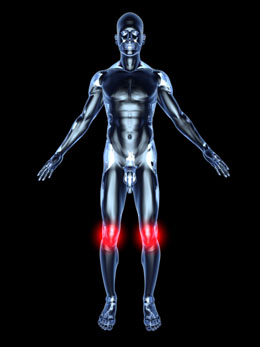It is important to understand the causes of pain in the inner knee so that the line of treatment can be decided upon. This ensures that the problem is rectified at the earliest. Refer to the following article for the causes and possible treatment in such a situation.

Knee pain is counted among the most common musculoskeletal discomforts. One will hear about this problem more often due to the increased activity levels which give rise to it. The knee joint can be straightened, bent, twisted, and rotated as well. All these movements often increase the risk of acute injuries caused by overuse. Being one of the largest and most complicated joints, used for all the weight-bearing activities of the body, the knee is also the most easily injured part of the body.
Inner knee pain, also known as medial knee pain, can also result from poor form during physical activity, insufficient warming up or cooling down, and at times, also due to inadequate stretching.
Causes
Pain in the inner knee can be caused due to overuse when small stresses are repeated, and the joint is not able to recover from them. A number of people complain of such pain while running. In such cases, it is often caused due to not warming up sufficiently. The body is in a state of shock, due to which it reacts and gives rise to pain. Excessive jumping can also give rise to such kind of pain. The two main causes of inner knee discomfort are medial ligament disorders and medial cartilage tear.
Medial Ligament Disorder: This is a serious type of injury. In this case, the medial meniscus, composed of the cartilage and surrounding quadriceps muscles, may also be damaged or hurt. This disorder is caused due to sudden jerking movements, which usually involve twisting during a landing motion where the knee collapses inwards. It can also be caused by awkward landing where the weight of the body is too much for the inner muscles and ligaments to bear. In some cases, the person may also feel the wear and tear, and hence, hear the popping noise at the time of damage. In such a case, the joint swells quickly, and a sharp pain can also be felt. The person may also suffer from throbbing soreness, and may have to limp.
Medial Cartilage Tear: There are two menisci located in the knee, and they rest between the thigh bone and the shin bone. They behave like shock absorbers, and are made of tough cartilage, conforming to the surfaces of the bones where they rest. These cartilages are responsible for distributing the weight of the body evenly over the joint. An injured cartilage will lead to uneven distribution of weight, and cause excessive forces in specific areas of the bone, leading to early damage. Such an injury usually occurs during heavy-duty running.
Treating The Pain
- For knee pain relief, ice therapy and preventing movement of the affected knee joint are the two important measures. These will help decrease swelling and pain in the joint.
- Keeping the leg on an elevation will help give some relief to the knee.
- Whether you are an athlete or not, strengthening and correctly training the thigh and quadriceps muscles will help alleviate any kind of pain or discomfort to the medial part of the knees.
- There are a number of exercises which will also help alleviate the condition. Water exercises often help in this condition, as water provides natural resistance without putting much stress on the joints.
Remember not to over-stress your knee. At the same time, do not forget to stretch before and after exercising. It is also recommended that you visit your healthcare professional for further treatment. A physical examination is necessary to determine the cause of the problem, and the further course of treatment.
Disclaimer: This Buzzle article is solely for informative purpose and not intended to replace the advice of medical experts. Before you take any measures for pain in the inner knee, make sure you have consulted your physician about the same.


 Knee pain is counted among the most common musculoskeletal discomforts. One will hear about this problem more often due to the increased activity levels which give rise to it. The knee joint can be straightened, bent, twisted, and rotated as well. All these movements often increase the risk of acute injuries caused by overuse. Being one of the largest and most complicated joints, used for all the weight-bearing activities of the body, the knee is also the most easily injured part of the body.
Knee pain is counted among the most common musculoskeletal discomforts. One will hear about this problem more often due to the increased activity levels which give rise to it. The knee joint can be straightened, bent, twisted, and rotated as well. All these movements often increase the risk of acute injuries caused by overuse. Being one of the largest and most complicated joints, used for all the weight-bearing activities of the body, the knee is also the most easily injured part of the body.